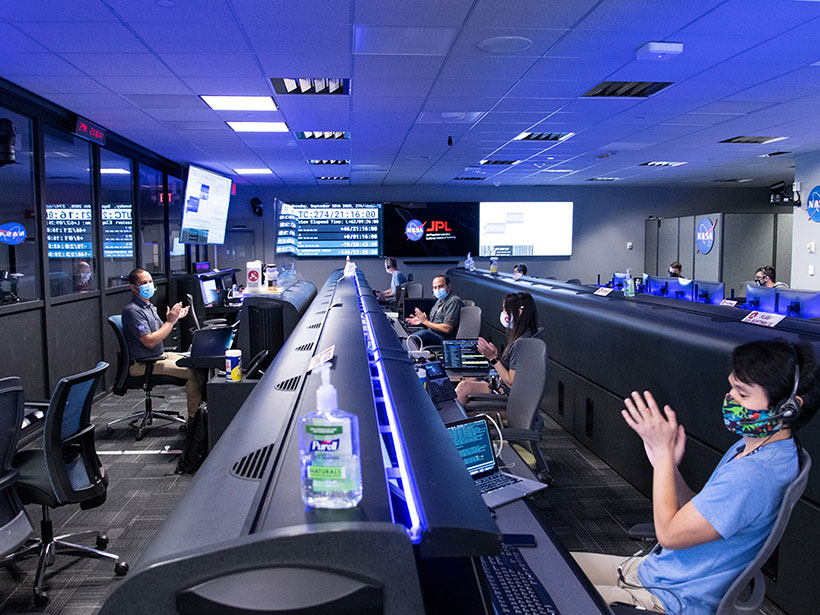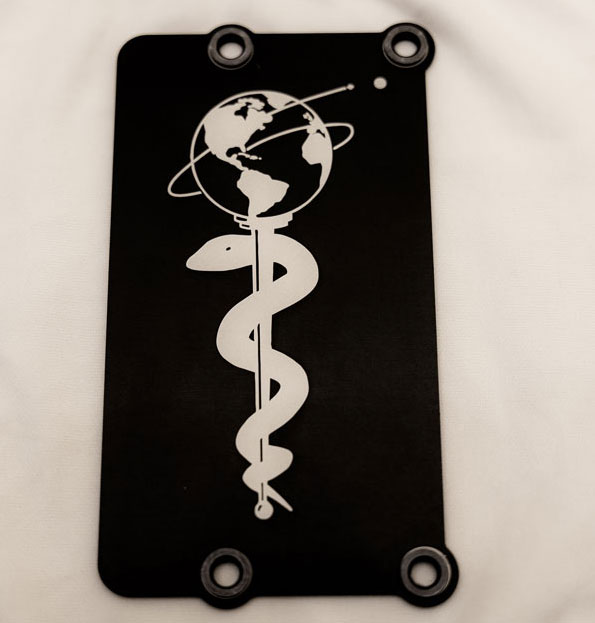For the people operating Curiosity and earlier Mars rovers, the first 3 months after landing were like a big slumber party. Scientists from around the world congregated at the Jet Propulsion Laboratory (JPL) in Pasadena, Calif., to check out and begin using the instruments, huddling together over their consoles as the observations flowed in. They all worked on “Mars time,” so their schedules slipped out of sync with the world around them.
“Even though everybody is living on Mars time and having the challenges that that poses, you’re going through it together,” said Katie Stack Morgan, a scientist on the Curiosity rover and deputy project scientist for the next rover, Perseverance. “JPL has an ice cream chest for missions that was refreshed every week, so you had folks lining up to get the best ice cream early in the week. You got to know all the 24-hour places in L.A. where you can have a bite to eat after your shift. So while it’s hard, it’s also kind of fun. It was exciting.”
For Perseverance, though, the excitement will be almost all virtual. Thanks to COVID-19 restrictions, most mission scientists, including those based at JPL, will work from home. Control rooms will be relatively deserted, as only mission-critical engineers and technicians report to campus, and some team members with family issues or other complications will have to eschew Mars time entirely. Those who staff campus facilities will face enhanced safety rules, from restrictions on how and where they can eat and drink to requirements that they carry their own headsets and keypads between stations.

“It’s a completely different experience,” said Fernando Abilleira, deputy mission manager for the launch through landing phases of the mission. “I’ve missed the usual face-to-face interaction. It’s definitely a challenge—it’s harder to work virtually.”
Searching for Life, Preparing for the Future
Perseverance—also known as Mars 2020—is scheduled to land in Jezero Crater on 18 February. A river flowed into the crater 3.5 billion years ago, forming a deep lake, and Perseverance will explore the river delta for evidence of past microscopic life. It also will collect samples of rocks and dirt for potential return to Earth by a future rover and evaluate technologies for crewed Mars missions. During the early weeks, it will deploy the Ingenuity helicopter, a technology demonstrator for future missions.
Most mission operations, such as driving the rover and flying the helicopter, will take place during daylight on Mars. Since a Mars day (known as a sol) is about 40 minutes longer than an Earth day, operators must shift their work schedules to synchronize with their charge—a change that’s difficult even without COVID-19.
“I did it for a few weeks with Mars Science Laboratory [MSL, Curiosity], and it’s tiring,” said Raymond Francis, a JPL mission operations engineer for Perseverance. “You’re up at strange times of day, and you’re working long shifts where you have to be fully mentally engaged. Some people adapt to it better than others.”Team members are advised to remain on Mars time during their off days, Francis said, and to use blackout curtains to help them sleep. (Francis, who will work from JPL for much of the first 90 sols, has covered his bedroom windows with aluminum foil.)
COVID-19 complicates the adjustment because many team members will spend at least some of their time working from home, having to balance rover sessions with laundry, homework, daycare pickup, and other domestic obligations.
Of course, most team members have plenty of experience with such juggling acts by now. COVID-19 restrictions began months before Perseverance’s launch on 30 July 2020, so many of the project’s engineers and most of its scientists had to complete their preparations from home. And over the months both before and since then, they’ve found ways to adapt to the new “nominal,” including dealing with potential interruptions that are less of a threat from the JPL campus.
Keeping the Lights on and the Internet Connected
“There’s a greater risk when you do activities remotely,” said Abilleira, who has three children at home. To minimize fire risks, for example, electric companies in Southern California sometimes shut off the power when high winds are forecast. And even when the power is on, neighborhoods sometimes lose Internet service. To stay connected, some team members have signed up with more than one Internet service provider, and they can use their smartphones as Wi-Fi hot spots to connect to a virtual private network at JPL. And to keep the lights on, Abilleira and others have installed batteries or generators.
In addition, “we do a lot of backup planning,” said Vandi Verma, chief engineer for Mars 2020 robotics operations and one of the rover’s drivers. “Our COVID planning is pretty elaborate. Anyone could get sick, so we need a backup for every role.”

Verma, who has two young children, works from a corner of her bedroom while her husband, a fellow rover driver, sets up at the dining table. “From landing through the first 90 sols, one or the other of us will be on duty every day, but one of us will always be available to be the responsible parent. It’s going to be fun,” she said.
To minimize disruptions, most of the daily hands-on operations will take place from JPL’s mission control room and other campus facilities—although with drastically reduced staffing. While 52 people were in the control room when Curiosity landed on Mars in 2012, for example, only 29 are scheduled to be there for the Perseverance touchdown. Support rooms that typically seat two or three dozen scientists and engineers will be limited to just a handful.
JPL has installed new ventilation systems in some of the rooms, and in addition to the standard COVID-19 precautions—masks and social distancing—it has added a few more. Team members will be allowed to drink a beverage only through a straw, for example, and they won’t be allowed to eat while “on console.” Instead, they’ll have to reserve a special room for a meal or snack—one person at a time—or step outside. “That’s one of the biggest changes,” Francis said. “You really have to plan your eating.”
Each team member has been assigned an individual keyboard and headset, which must be carried along when they change rooms or even workstations. The gear will be stored in lockers when users are off duty and will be disinfected daily.
Beating the Stress
To minimize stress, mission leaders plan to give people more scheduling flexibility. “We recognize that everybody has a different situation,” said Stack Morgan, who moved to Utah for 6 months last year with her husband and two young sons to get more space. “We’re giving each other a bit more grace, a bit more understanding.”
Even so, it can be tough for project participants to integrate into the team when they can’t see each other in person, especially for those who are far from Pasadena. “With MSL, I went to JPL and got to know the science team really well,” said Mariek Schmidt, an associate professor at Brock University in Ontario, Canada, who recently joined the Perseverance mission. (Schmidt has two youngsters at home and is teaching an online class this semester.) “Now, I feel disconnected from the Mars 2020 team. I know a lot of people from MSL, but I haven’t had that face-to-face time with them this time. It’s a very different feeling.”Science team managers have tried to devise activities to bring the team together, such as sharing pictures of their home work environments and playing “baby photo Jeopardy” during a Christmas party, Stack Morgan said. “We’re trying to think of other things we can incorporate into the mission. None of these will take the place of an ice cream chest, but they may help us feel that we’re part of a real human team.”
Ultimately, team members say they are confident they will overcome the challenges and help get Perseverance’s mission to a good start. “In the end, we were always going to collaborate remotely with the rover,” said Francis. “Now we’re collaborating remotely with each other at the same time. We’ll get through it.”
—Damond Benningfield ([email protected]), Science Writer
"time" - Google News
February 17, 2021 at 09:09PM
https://ift.tt/3qpIfLz
A Bad Time for Mars Time - Eos
"time" - Google News
https://ift.tt/3f5iuuC
Shoes Man Tutorial
Pos News Update
Meme Update
Korean Entertainment News
Japan News Update
Bagikan Berita Ini














0 Response to "A Bad Time for Mars Time - Eos"
Post a Comment